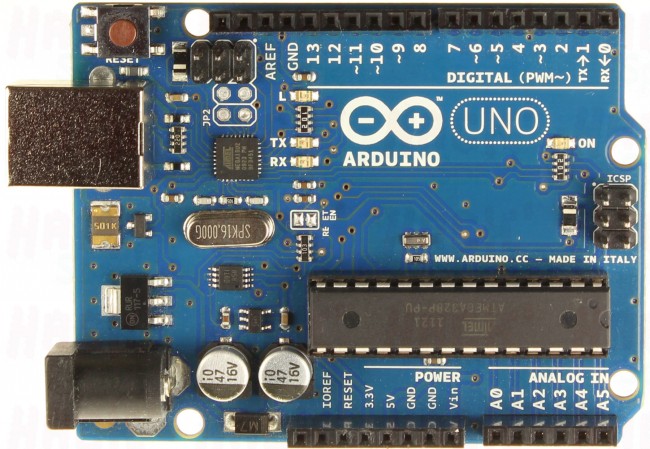The Arduino UNO board is the most robust and widely used Arduino microcontroller. Ideal for starting to learn electronics and programming.
Microcontroller features
The Arduino UNO microcontroller uses the ATmega328P microprocessor. This processor operates at a clock frequency of 16 MHz. It has 2 kB RAM, 1 kB EEPROM and 32 kB Flash memory (for programming and data logging).
|
Power supply
The Arduino UNO microcontroller operates over a voltage range of 7-12V, thanks to its on-board voltage regulator, while the microprocessor operates at 5V. In normal operation, the microcontroller consumes up to 45mA (if no power is supplied) and can accept a current of 20mA (absolute maximum 40mA) on each of its IO pins. There is a 200mA limit for the whole board.
Pinout
- Analog I/O : 6 (A0, A1, A2, A3, A4, A5)
- Digital I/O : 8 (0, 1, 2, 4, 7, 8, 12, 13)
- PWM pins: 6 (3, 5, 6, 9, 10, 11)
- Communication Serial: 14 (0, 1, 2, 3, 4, 5, 6, 7, 8, 9, 10, 11, 12, 13)
- I2C communication : 1 ((‘A4’, ‘A5’))
- SPI communication: 1 ((10, 13, 12, 11))
- Interrupt: 2 (2, 3)
Basic code and pin identification
To use the input/output pins in the code, simply use the labels present on the board, i.e. A0-A5 and 0-13. Pins A0, A1, A2, A3, A4 and A5 can also be replaced by 14, 15, 16, 17, 18 and 19 respectively. For your information, analog pins can also be used as digital I/Os.
const int analogPin=A0; // broches A0-A5 ou 14-19 const int digitalInPin=2; // broches 0-13 et 14-19 const int digitalOutPin=4; // broches 0-13 et 14-19 const int pwmPin=3; // broches 3 5 6 9 10 11 int analogVal=0; int digitalState=LOW; int pwmVal=250; void setup() { Serial.begin(9600); //broches 0(Rx) et 1(Tx) pinMode(analogPin,INPUT_PULLUP); // broches 0-13 et 14-19, Argument OUTPUT, INPUT, INPUT_PULLUP pinMode(digitalInPin,INPUT); pinMode(digitalOutPin,OUTPUT); pinMode(pwmPin,OUTPUT); } void loop() { analogVal=analogRead(analogPin); // broches A0-A5 ou 14-19, return int digitalState=digitalRead(digitalInPin); // broches 0-13 et 14-19, return boolean digitalWrite(digitalOutPin,HIGH); //broches 0-13 et 14-19, valeur LOW(0) ou HIGH(1) analogWrite(pwmPin,pwmVal);// broches 3 5 6 9 10 11, valeur 0-255 }
Summary of features
| Microcontrôleur | |
| Nom: | Arduino UNO |
| Marque: | Arduino |
| Caractéristiques | |
| CPU: | ATmega328P |
| Tension d’alimentation : | 7-12V |
| Tension logique: | 5V |
| E/S digitales: | 14 |
| Entrées analogiques: | 6 |
| Flash: | 32kB |
| SRAM: | 2kB |
| EEPROM: | 1kB |
| Fréquence d’horloge: | 16 MHz |
| Wifi: | No |
| Bluetooth: | No |
| SD card: | No |
| Touch: | No |
| UART/SPI/I2C/I2S: | Yes/Yes/Yes/No |
How to get started
Microcontrôleur Arduino UNO
La fameuse carte Arduino UNO basée sur l’ATmega328. Idéale pour le prototypage rapide et les personnes qui se lance dans la programmation et l’électronique

